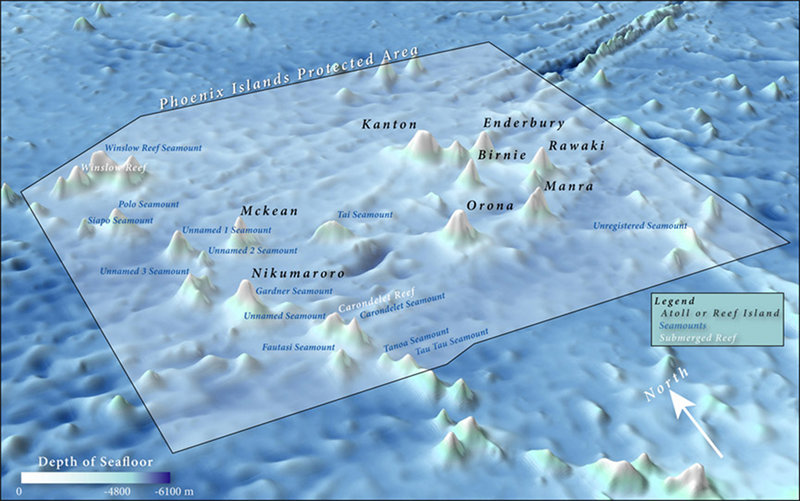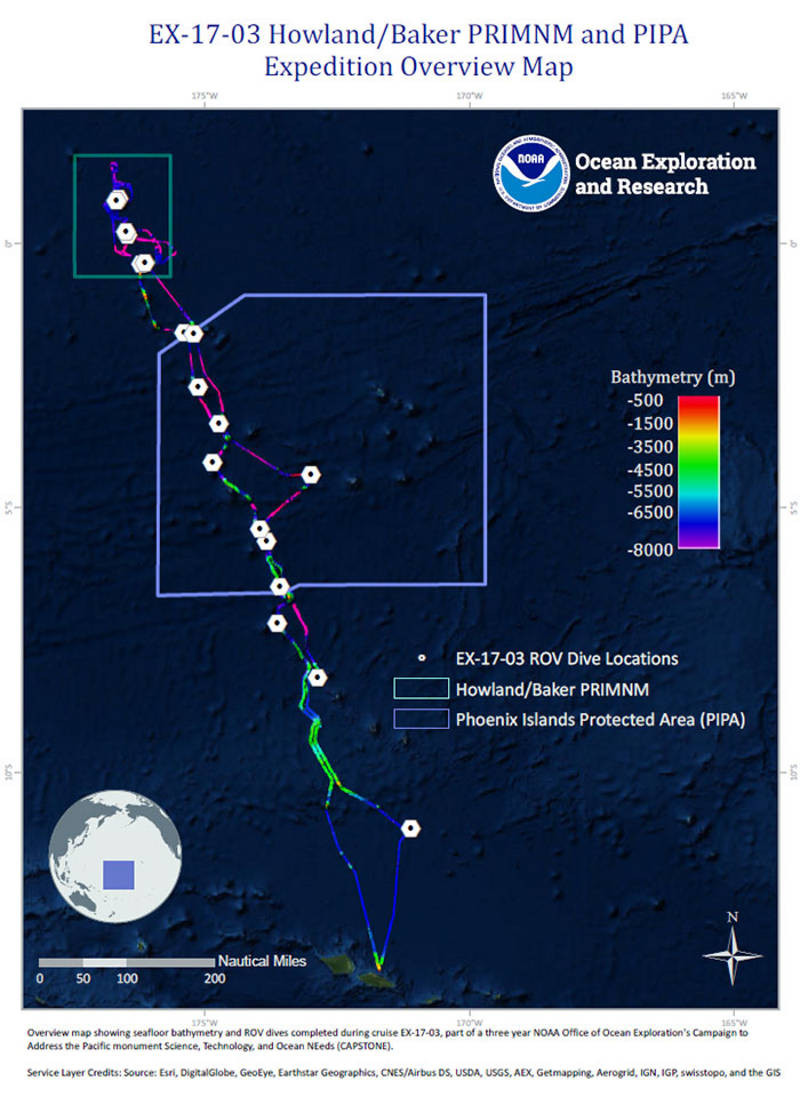

Bathymetric map detailing the seamounts and submerged reefs located within the Phoenix Islands Protected Area. Image courtesy of Kerry Lagueux / Anderson Cabot Center for Ocean Life, New England Aquarium. Download larger version (jpg, 291 KB).
For the past three years, NOAA and several partners have been conducting a ‘Campaign to Address Pacific monument Science, Technology, and Ocean NEeds (CAPSTONE)’. CAPSTONE has been a major multi-year science initiative to collect deepwater baseline information to support science and management decisions in and around U.S. marine protected areas in the central and western Pacific. These areas contain some of the last relatively pristine marine ecosystems on the planet and harbor numerous protected species, undiscovered shipwrecks, and cultural landscapes. Their designation is unprecedented in terms of geographic scope, ecological value, and national symbolism for ocean conservation.

The March 2017 Discovering the Deep: Exploring Remote Pacific Marine Protected Areas expedition was a 23-day telepresence-enabled expedition to collect critical baseline information about unknown and poorly known deepwater areas in the Howland and Baker Unit of the Pacific Remote Islands Marine National Monument, now known as Pacific Islands Heritage Marine National Monument, American Samoa, the Phoenix Islands Protected Area, and the waters around New Zealand's Territory of Tokelau. Image courtesy of the NOAA Office of Ocean Exploration and Research, Discovering the Deep: Exploring Remote Pacific MPAs. Download image (jpg, 115 KB).
October 5 – November 1, 2017, the Discovering Deep-Sea Corals of the Phoenix Islands expedition aboard the Schmidt Ocean Institute’s (SOI’s) R/V Falkor will further the March 2017 work of NOAA Ship Okeanos Explorer to investigate never before seen seamounts and atolls within the Phoenix Island Marine Protected Area (PIPA) in the central Pacific Ocean.
PIPA is the largest and deepest UNESCO World Heritage Site on Earth. Approximately the size of California, PIPA was the first marine protected area (MPA) of its kind and lies about halfway between Hawaii and Fiji, within the territorial waters of the Republic of Kiribati.
Eight islands exist in this MPA, and beneath the water lie over 25 volcanoes. Here, seamounts, atolls, and submerged reefs create one of the last isolated and virtually untouched coral archipelago ecosystems, teeming with life. PIPA is also the first protected area in Pacific where depths exceed 5,000 meters (16,400 feet), and entirely unknown species are sure to live at those depths.
Exploration in this area is an extension of the very first exploration of NOAA Ship Okeanos Explorer in Indonesia in 2010. Results of that expedition identified that deepwater coral biodiversity is as rich as shallow-water coral diversity in the coral Triangle region of the Western Pacific. Big questions for this expedition include: “Why does this biodiversity exist in the deep sea?” and “What sort of connections are there between shallow water environments and the deep sea?”
Scientists will explore this essentially unspoiled environment using multibeam sonar, SOI’s remotely operated vehicle, SuBastian , and other tools and sensors. Live real-time footage of all ROV dives will be streamed from Schmidt Ocean Institute’s YouTube page and from their website . Follow them on Facebook , Twitter , and Instagram for daily updates as well as live ship-to-shore connections, which you can sign up for here .